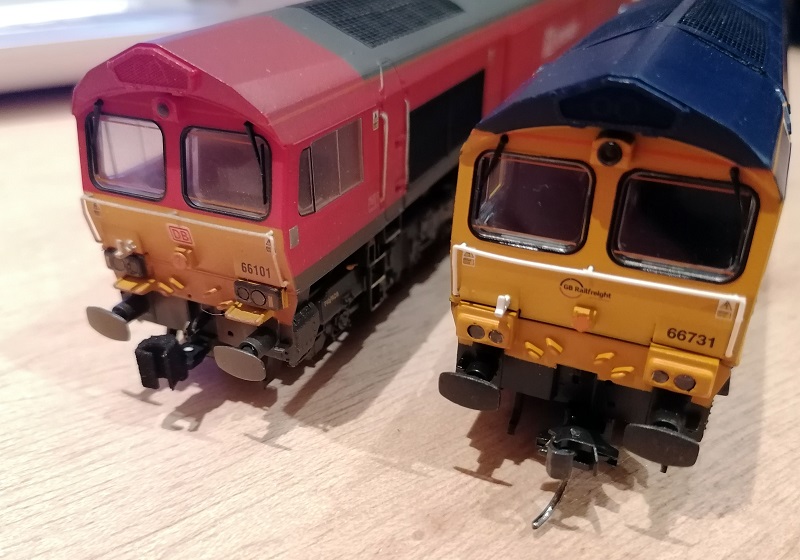It’s been a few weeks since my last post partly because of work but mostly because I’ve been out enjoying the sunshine! But I’ve also put some time into finishing off the RT-624 HO project and it’s now ready for a test print.
The two versions of the Pennsylvania Railroad’s Baldwin RT-624, as shown below, are very similar but there are little differences that mark the change in the two different batches ordered.

The first depicts the original batch of fourteen units, numbered 8952 to 8965. With the exception of 8952 and 8953, they were fitted with the PRR Trainphone. This has mostly been modeled with etched brass. The item on the front, which I mistook for a bell, is actually the receiver for the Trainphone, with the antenna along the roof working as the transmitter. Thanks to Norman Bell and Gus Foster for the information.
Gus said ‘The device you were questioning on the top of the train-phone-equipped RT-624 is the train-phone receiver. These were disk-shaped devices consisting of a coil of wire that acted as a receiving antenna for the induction radio equipment used in the late 1940’s and 50’s.
As you may be aware, the train-phone system induced electromagnetic signals into the rails and the signal wires that ran parallel to the tracks. The government did not open radio communication frequencies to railroads and others until later in the 1950’s. As a result, the PRR used a radio induction communication system known as “trainphone” for communication between locomotives, cabin cars (cabooses), interlocking towers and railroad stations. The “handrail” shaped equipment on the top of diesel locomotives, cabins and tenders were the sending antennae that induced the signal out to the rails and parallel metallic conductors. The receivers picked up the signal. So to send and receive, both the antenna and receiver had to be near the location of the radio.‘
The receiver on my RT-624 is 3D printed but I’ve designed it to be a separate part to be fitted later as I can see it easily getting broken off during shipping.


The later batch, numbered 8113 and 8724 to 8731, had no Trainphone equipment and a lowered headlight. They also rode on General Steel Castings Delta equalized trucks as opposed to the General Steel Castings Commonwealth trucks used on the first batch. Currently I’m using Bowsers truck frames for both, along with my truck centers which are required to rotate the trucks 180°, but I’m considering offering a 3D printed set of each truck frame.


The handrail on the end is split by the fold down walkway and MU hoses. I haven’t modelled the MU hoses yet. I have the ones I did for my N scale version but they look huge in HO so I’m re-thinking that and I may make them as brass parts that clip in. The center section will be 3D printed and again it’ll be a separate part to protect it when shipping. The corner handrails will be brass and will fix through holes in the center section to ensure a strong and accurate fit.

And that’s it, the HO RT-624 is ready for a test print. I’m planning on printing the early version with the Trainphone because that one will have more things to check. While the test print is in production I’ll update the etched brass parts sheet for the different parts. Most are the same as the DT6-6-2000 but there are differences; I can’t use the same etch as one of the four main handrails is a different shape. In the image below I’ve circled the walkway which is longer, pushing the crank in the handrail further along.

Once the test print arrives, it should be easy to check it fits as I have the Bowser chassis here that I used with my HO DT6-6-2000. It will also get the powered Kadee couplings so it can be tested doing some switching and I’ll share that with you, well as long as it doesn’t continue to be sunny outside!


























 As the Black Versatile Plastic ones come pre coloured, are more flexible, strong and don’t need to be cleaned before painting I think these will be the ones to use. But as with the new 3 Link and Instanter fixed couplings it’s now off to the actual OO railway for some proper testing before I’ll know if they really work. I’ll let you know more when the testing is done.
As the Black Versatile Plastic ones come pre coloured, are more flexible, strong and don’t need to be cleaned before painting I think these will be the ones to use. But as with the new 3 Link and Instanter fixed couplings it’s now off to the actual OO railway for some proper testing before I’ll know if they really work. I’ll let you know more when the testing is done.





You must be logged in to post a comment.